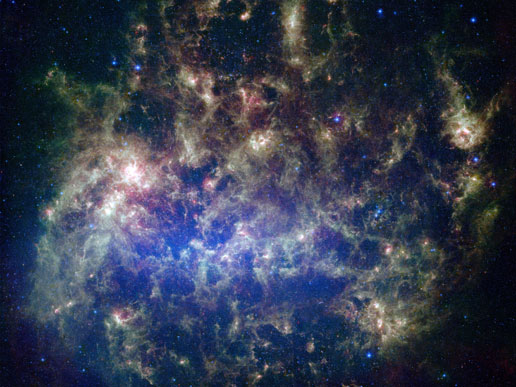Astronomers in the southern hemisphere are lucky enough to have a clear view of the Large and Small Magellanic Clouds. Those of us in the northern hemisphere are totally out of luck. The Large Magellanic Cloud is a dwarf galaxy located about 160,000 light years away. In fact, it’s the third closest galaxy after the Sagittarius Dwarf and the Canis Major Dwarf Galaxies.
The Large Magellanic Cloud is only about 1/10th the mass of the Milky Way, containing a mere 10 billion stars worth of mass. This makes it the 4th most massive galaxy in our Local Group of galaxies, after Andromeda, the Milky Way and the Triangulum Galaxies.
It’s considered an irregular galaxy, without the grand spiral shape that we see with other galaxies, but it does have a prominent central bar. It’s possible that the Large Magellanic Cloud was once a spiral galaxy like the Milky Way, but a near pass with our galaxy or another distorted its shape, wiping away the spiral formation.
You can see the Large Magellanic Cloud with the unaided eye; no telescope is necessary. It’s visible as a faint cloud in the night sky, right on the border between the constellations of Dorado and Mensa. With a good pair of binoculars, you can see it much better; and it’s even bigger and brighter in a small telescope.
The Large Magellanic Cloud has large pockets of gas and dust, and it’s undergoing furious star formation. In fact, some of the largest, most active star forming regions ever observed are in the LMC. Astronomers have found 60 globular clusters, 400 planetary nebulae, and 700 open clusters, with hundreds of thousands of giant and supergiant stars.
In 1987, a supernova detonated in the Large Magellanic Cloud – the brightest supernova seen in 300 years. For a brief time, the supernova was visible with the unaided eye. The supernova remnant is still being studied as it continues to evolve and expand.
The Large Magellanic Cloud is named after the explorer Ferdinand Magellan, who completed the first circumnavigation of the Earth between 1519-22, and saw the clouds as part of his travels.
We have written many articles about galaxies for Universe Today. Here’s an article the describes how the LMC is moving past the Milky Way too quickly to have been captured by our gravity.
If you’d like more info on galaxies, check out Hubblesite’s News Releases on Galaxies, and here’s NASA’s Science Page on Galaxies.
We have also recorded an episode of Astronomy Cast about galaxies – Episode 97: Galaxies.
References:
NASA APOD
NASA: The Nearest Galaxies
Keele University
Wikipedia

